#countess of southampton
Explore tagged Tumblr posts
Text
If Sir Thomas Gray's letter of confession to Henry V can be believed, Cambridge in the summer of 1415 was entertaining fantastic delusions. He told Gray, who was staying at Conisborough castle on 17 June, that the Scottish regent, Robert Stewart (c. 1340-1420), duke of Albany, was willing to trade the pseudo-Richard II in exchange for one of eighteen prominent Englishmen, headed by Bishop Courtenay of Norwich (one of the king's most trusted councillors), and the head of the Nevill clan, the staunchly Lancastrian Ralph, earl of Westmorland, who was married to Henry V's aunt, Joan Beaufort. Needless to say, there was no possibility that men of high rank would put themselves at Cambridge's disposal or become available to be used as hostages in these bizarre negotiations. Perhaps the Scottish regent, unwilling to disclose that his puppet was no longer alive, and eager to keep up the pretence that Richard II still survived, had stated unacceptable terms to evade coming to an agreement with Cambridge. It should have been obvious to Sir Thomas Gray as he rode homewards that his host, the earl of Cambridge, had lost touch with reality, and memories of that astonishing conversation at Conisborough castle, when the two men rashly talked of treason, should have been enough to deter him from getting more deeply involved in such preposterous schemes.
T. B. Pugh, Henry V and the Southampton Plot (Alan Sutton, 1988)
#henry v#richard earl of cambridge#ralph neville earl of westmorland#joan beaufort countess of westmorland#richard courtenay bishop of norwich#sir thomas gray of heton#the southampton plot#historian: t. b. pugh#posting this because the idea of the southampton plot targetting hal's besties on top of everything else makes me feral
8 notes
·
View notes
Text
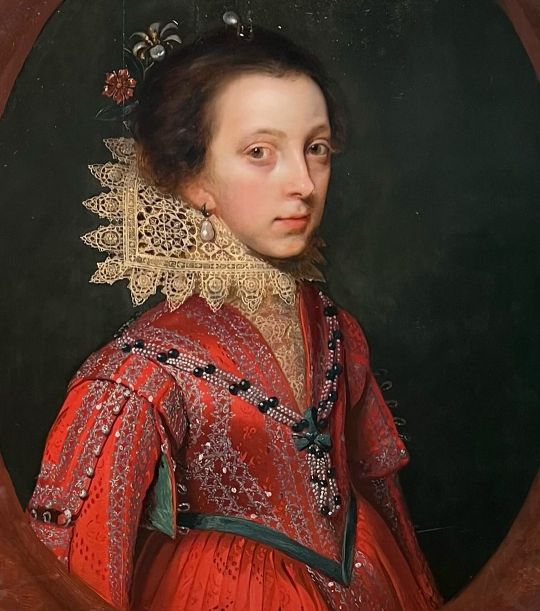
Rachel de Ruvigny, Countess of Southampton, Cornelius Johnson, early 17th century .. @intheenglishstyle ..
105 notes
·
View notes
Text

Anthony van Dyck (Flemish, 1599-1641)
Rachel Wriothesley, Countess of Southampton as Fortune, 1630
oil on canvas
17 notes
·
View notes
Text
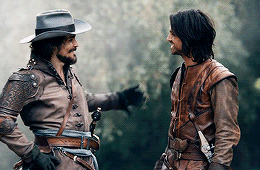
CHARACTER STATS BELOW THE CUT.
𝐁𝐀𝐒𝐈𝐂𝐒
full name : percival henry wriothesley.
meaning :
percival : Created by the 12th-century French poet Chrétien de Troyes for his poem Perceval, the Story of the Grail. Chrétien may have derived the name from Old French perce val "pierce the valley", or he may have based it loosely on the Welsh name Peredur .
henry : From the Germanic name Heimirich meaning "home ruler", composed of the elements heim "home" and rih "ruler". It was later commonly spelled Heinrich, with the spelling altered due to the influence of other Germanic names like Haganrich, in which the first element is hag "enclosure".
wriothesley : The surname Wriothesley was first found in Staffordshire where the family name was first referenced in the year 1170 when Adam de Wrotteslega held estates in that shire.
pronunciation : p-ER-s-ih-v-uh-l hen-ree RYE-uths-lee
monikers : percy, pers.
title : lord wriothesley of southampton ( 1532 - current ).
age : twenty seven.
gender + pronouns : trans male & he / him .
sexual orientation : pansexual ( grey ) & panromantic ( grey ).
status : lord wriothesley, companion and advisor to the king .
𝐁𝐀𝐂𝐊𝐆𝐑𝐎𝐔𝐍𝐃
date of birth : october 3rd, 1532.
place of birth : hampton court , the king's advisor's suites.
nationality : english.
religion : the church of england / protestant .
family : the wriothesley family of southampton, staffordshire & titchfield.
father : Thomas Wriothesley , Earl of Southampton, Baron Wriothesley. ( BORN 1505. )
mother : Jane Wriothesley , ( nee Cheney. ) , Countess of Southampton , Lady Courtesy . ( BORN: 1509. )
siblings:
FIRST SON: Gideon Thomas Wriothesley . ( BORN 1526 )
FIRST DAUGHTER: Matilda Wriothesley . ( BORN 1528 )
SECOND DAUGHTER: Constance Wriothesley . ( BORN 1536 )
THIRD SON: Nathaniel Wriothesley . ( BORN 1538 )
FOURTH SON: Christopher Wriothesley . ( BORN 1538 )
THIRD DAUGHTER: Madeleine Wriothesley . ( BORN 1540 )
marital status : unengaged , with no broken engagements prior.
issue : none.
𝐏𝐇𝐘𝐒𝐈𝐂𝐀𝐋𝐈𝐓𝐘
faceclaim : Luke Pasqualino.
hair : Falling to the shoulder, thick and dark, a deep reddish brown.
eyes : Darker still than his hair, his eyes are almost black.
complexion : A deep olive, brought deeper by his time in the sun and outside pursuits.
height : 6'0
build : Mesomorph. While on the leaner side, he is toned and built up in muscle. Training focus more on athleticism, speed and stealth than strength, he holds most of his muscles in his arms due to archery and legs due to stamina training.
distinguishable markings or scars : nicks and cut scars around his body from jousts and training, including callouses on his palms and fingers. Otherwise, some freckling on his cheeks and nose, his hands and forearms, and a spattering of moles and birthmarks across his body.
scent : From a small pouch he keeps upon his person to mask his scent from hounds and remove the day's sweats, he carries a medley of herbs and wildflowers, including pine, rosemary and thyme.
𝐏𝐄𝐑𝐒𝐎𝐍𝐀𝐋𝐈𝐓𝐘
dominant hand : right.
zodiac sign : libra sun, aquarius moon, libra rising.
mbti : intj-a
alignment : lawful neutral.
temperament : melancholic.
positive traits : meticulous, eloquent, captivating, dutiful, loyal.
negative traits : vitriolic , stoic , reticent , indulgent , possessive .
skills or hobbies : an accomplished hunter and archer, as well as trained in warcraft and swordsmanship. however, his true passions lay in the arts-- he plays both the flute and the lute. Enjoys the drawn arts , and often partakes in portraiture. Also reads literature and enjoys theatre and spoken word.
habits : Digging his fingernails into his palms to ground himself. Running his hands through his hair. Exhaling and huffing. Little 'looks' to notion humour, including raised brows.
7 notes
·
View notes
Text
Court Circular | 3rd February 2023
Buckingham Palace
The King was represented by Major General Christopher Elliott (formerly Colonel, The Royal Regiment of Wales, 24th/41st Foot) at the Funeral of Lieutenant Colonel Gordon Amphlett (formerly Regimental Sergeant Major, The Royal Regiment of Wales, 24th/41st Foot) which was held in Brecon Cathedral this afternoon. By command of The King, Mr Alistair Harrison (Marshal of the Diplomatic Corps) called upon His Excellency Mr Umit Yalcin at 43 Belgrave Square, London SW1, this morning in order to bid farewell to His Excellency upon relinquishing his appointment as Ambassador from the Republic of Türkiye to the Court of St James’s.
St James’s Palace
The Earl of Wessex, Patron, the Tennis and Rackets Association, this evening attended the Seacourt Silver Racquet Fiftieth Anniversary Dinner at Seacourt Tennis Club, 20 Victoria Avenue, Hayling Island, and was received by His Majesty’s Lord-Lieutenant of Hampshire (Mr Nigel Atkinson). The Countess of Wessex, accompanied by His Majesty’s Ambassador to the Kingdom of the Netherlands (Her Excellency Mrs Joanna Roper), this morning visited the International Commission on Missing Persons, Koninginnegracht 12, the Hague, the Netherlands. Her Royal Highness, Global Ambassador, The Duke of Edinburgh’s International Award Foundation, today attended a Reception for young people who have achieved the Gold Standard in the Award, at the Residence of His Majesty’s Ambassador to the Kingdom of the Netherlands in the Hague. The Countess of Wessex this afternoon planted a tree for The late Queen’s Platinum Jubilee in the garden of the Residence of His Majesty’s Ambassador to the Kingdom of the Netherlands. Her Royal Highness later arrived at London City Airport, London, from the Netherlands. Mr Alexander Stonor and Mrs Angus Galletley were in attendance.
St James’s Palace
The Princess Royal, Patron, the Royal College of Midwives, this morning visited Princess Anne Hospital at University Hospital Southampton NHS Foundation Trust, Coxford Road, Southampton, and was received by Major General James Balfour (Deputy Lieutenant of Hampshire). Her Royal Highness afterwards attended a Reception at Southampton Civic Centre, Civic Centre Road, Southampton, to recognise Southampton being awarded Lord Mayoralty status as part of The late Queen’s Platinum Jubilee celebrations and was received by His Majesty’s Lord-Lieutenant of Hampshire (Mr Nigel Atkinson). The Princess Royal this afternoon opened Linden House, Society of St James, 44-46 Station Road, Woolston, Southampton, and was received by Professor Khalid Aziz (Deputy Lieutenant of Hampshire).
#court circular#princess anne#princess royal#king charles iii#earl of wessex#countess of wessex#british royal family
7 notes
·
View notes
Photo


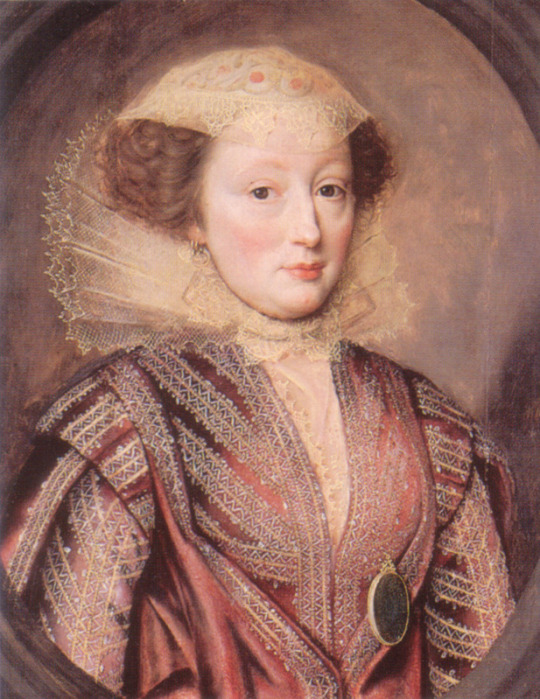
Closing out the Renaissance Era (from top to bottom) -
1615 Déjeuner en plein-air by Esaias van de Velde (Rijksmuseum). From tumblr.com/andrayblue 2048X1160 @72 653kj.
1615 Lady in a Red Dress by English School (location ?). From tumblr.com/lenkaastrelenkaa 693X900 @72 334kj.
ca. 1618 Elizabeth Vernon Countess of Southampton by ? (location ?). From tumblr.com/catherinedefrance 617X799 @72 273kj.
#1610s fashion#late Renaissance fashion#Jacobean fashion#Esaias van de Velde#straight hair#curly hair#feathered hat#bib#maxi-length skirt#short hair#tabbed sleeves#lace collar#jeweled cap#high lace ruff#saya#rolled sleeves#hanging sleeves#false sleeves#Elizabeth Vernon#lace attifet#chemise#neckline ruff
6 notes
·
View notes
Text
Henry VI issued 21 deprivation orders, all of which were revoked; Edward IV had 140 people stripped and 86 overthrown; Richard III deprived 99 of 100 reversals; Henry VII, 138, 52 Reversal
John Bell, the main rebel in Kent County, according to the royal indictment, served from November 1483 to 1484.
William Bampton was nominated in January 1484 in Richard III's parliament for the Salisbury Uprising and was nominated elsewhere on October 18, 1483.
William Baskett, a gentleman, was awarded the Order of Salisbury in the Parliament of Richard III in January 1484 for his involvement in the Salisbury Uprising, and received the Order of Salisbury elsewhere on October 18, 1483.
Geoffrey Beauchamp was one of the main rebels accused by Lord Scrope on November 13, 1483 in Bodmin.
Richard Beauchamp, Lord Saint Amand, was awarded in January 1484 in the Parliament of Richard III for his uprising in Newbury, Berkshire, and other places on October 18, 1483 Roger Torkots' stepson.
Margaret Beaufort, Countess of Richmond, was elected in the third act of Parliament by Richard III in January 1484. The mother of the king's great rebel and traitor. She wrote a letter to Henry, telling him to start a war. She donated a large amount of money on charges of treason in London and other places, conspired to destroy the king and assist Buckingham. She was handed over to her husband Thomas Stanley for care.
William Berkeley, Knight of the Body, was awarded in January 1484 in Richard III's council for his uprising on October 18, 1483 in Newbury, Berkshire, and other places He has served as a police officer in Southampton and Winchester. In 1480, when Margaret of York visited England, he received her. He is suspected of colluding with Southampton Mayor Walter Mitchell, and his relative Edward is a town official. Joined the exiled Henry Tudor.
John Bevean, a gentleman, won an award in the Parliament of Richard III in January 1484 due to the Salisbury Uprising, and was awarded elsewhere on October 18, 1483.
James Blount, a police officer stationed in Hams, is a descendant of the York family who served Edward IV and fought for him to regain the throne.
He was the warden of John de Vere, Earl of Oxford. John de Vere was a stubborn Lancastrian who had been imprisoned in the Hams garrison on orders from Edward IV since 1475. On October 29, 1484, Richard III heard of a conspiracy to rescue him and ordered Oxford to return. However, James Blount and John Fortescue, the porter from Calais, defected to Henry Tudor and took Oxford with them. In December, Lord Darnham, the Governor of Calais, attacked and occupied Hams, imprisoning several people, including Brent's wife. In January 1485, Oxford and others returned to Hams to rescue them. In the ceasefire agreement, the Calais army allowed dissatisfied individuals to leave. They joined the ranks of Henry Tudor.
[Haha] [Haha] [Haha] [Haha] [Haha] [Haha] It's so funny
In January 1484, John Boutayne, a royal guard, was awarded a prize in Richard III's council for his uprisings in Kent and Surrey, Maidstone, Gravesend, Guilford, and other places from October 18 to October 25, 1483.
He was sent to Kent by John Howard, Duke of Norfolk and a staunch supporter of Richard III, to quell the uprising. However, during the riots at Gravesend Market on October 13, 1483, he killed 'Mr. Mobley'.
Under the rule of Edward IV, there were 40 body attendants; 24 people are from the south. Among these 24 people, 11 rebelled. Among the remaining 13 people, 5 lost their peace committee, and 2 rebelled in 1484.
Under the rule of Edward IV, there were 24 body knights; 10 people are from the south. Six out of ten people rose in 1483.
50% of Edward IV's Southern knights and attendants (17 out of 34 courtiers) led the uprising.
From 1478 to 1482, 48% of the people who served as sheriffs in 14 counties under Edward IV rebelled in 1483; 35% of security commissioners rebelled.
40% of southern judges and sheriffs rebelled.
35% of the security commissioners selected by Richard rebelled. This proportion has risen to 61%, including those who stepped down directly after the uprising.
Out of the 10 magistrates elected in November 1482, 4 rebelled.
0 notes
Photo

Mary Wriothesley, née Browne, Countess of Southampton (22 July 1552 - October/November 1607)
#mary browne#mary wriothesley#countess of southampton#daughter of anthony browne 1st viscount montagu#married henry wriothesley 2nd earl of southampton#then sir thomas heneage#then sir william hervey#history#women in history#art
1 note
·
View note
Text
The Titanic sailed today 110 years ago...with a Pig on board by Jina Bacarr
The Titanic sailed today 110 years ago...with a Pig on board by Jina Bacarr #Titanic #Titanic2022 #Ireland @BoldwoodBooks
Photos: Dreamstime.com — using RF stock, my interpretation of the ship and female passenger and of course, the little pig. Downton Abbey is but a memory… but it will be forever in our hearts. Do you remember that first scene when a messenger on a bicycle brought a telegram to the Crawley family that would forever change their lives? And ours? A telegram about two male relatives lost at sea. On…

View On WordPress
#Historical#1912. historical romance#British#Confessions of a Podcast Goddess#countess#Downton Abbey#England#Ireland#Irish#pig#romance&039;#ship of dreams#Southampton#Titanic#Titanic 104
0 notes
Text
Most portraits, of course, show only the stiffened outer bodice, and not the stays underneath. However, around 1595-1600 an unknown artist painted a rare depiction of a woman who is only partly dressed. Elizabeth Vernon, Countess of Southampton, is shown in intimate dishabille, combing her hair in her dressing room, her jacket open to reveal a pair of pink silk stays. The lower edge of her stays is tabbed and the front is laced. The bones are set vertically. According to the dress historian Naomi Tarrant, "The Countess has left her beautiful embroidered jacket undone whilst she does her hair, probably because she would not have been able to lift her arms with it fastened. In other words, the jacket was physically more restrictive than the stays.
- Valerie Steele, The Corset: a Cultural History (Yale University Press, 2001)
263 notes
·
View notes
Text

Queen Elizabeth II and Prince Philip, Duke of Edinburgh pictured together on the steps of Broadlands with Louis Mountbatten, 1st Earl Mountbatten of Burma and Edwina Mountbatten, Countess Mountbatten of Burma in Romsey near Southampton, Hampshire on April 6th 1957.
14 notes
·
View notes
Text

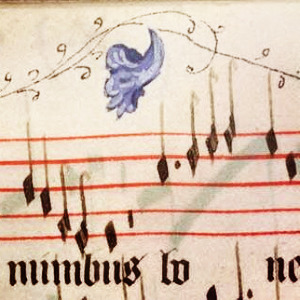


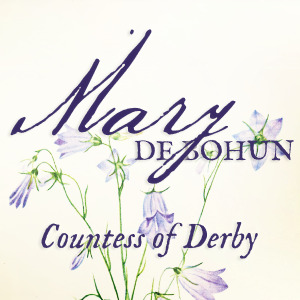
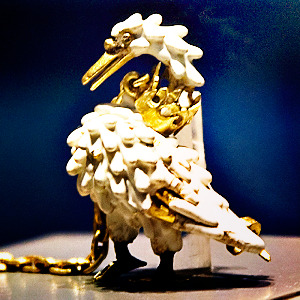


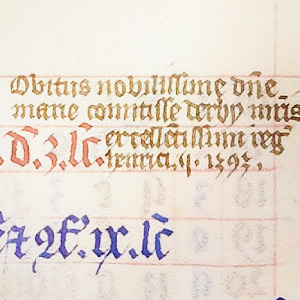
Mary de Bohun, Countess of Derby
Mary de Bohun was probably born around 22 December 1370 to Humphrey de Bohun and Joan Fitzalan, Earl and Countess of Hereford. As her father had no son, she and her elder sister, Eleanor, became the heiresses of his wealthy earldom. Eleanor married Thomas of Woodstock, the youngest son of Edward III, and according to Froissart, Woodstock intended Mary to enter a nunnery so he would inherit the entire earldom. This was not to be. In late 1380 or early 1381, Mary married John of Gaunt's son and heir, Henry Bolingbroke, the future Henry IV. The marriage appears to have happy as they shared similar interests and often spent time together. The story that Mary gave birth to a short-lived son in 1382, when she would have been only 11, is now believed to be a myth brought into being by a mistranslated text referring to her sister giving birth to a son. Mary's first child was the future Henry V, born 16 September 1386. Four more children soon followed: Thomas, Duke of Clarence (29 September 1387), John, Duke of Bedford (20 June 1389), Humphrey, Duke of Gloucester (3 October 1390) and Blanche, Electress Palatine (25 February 1392). Mary died either giving birth to her sixth and final child, Philippa, Queen of Norway, Denmark and Sweden, or from complications afterwards, on 1 July 1394, when she was only 23 years old. Mary was buried on 6 July 1394 in the Church of the Annunciation of Our Lady of the Newarke in Leicester. The church and her tomb was destroyed in the Reformation.
A little of her personality can be reconstructed. She was interested in music, playing the harp or cithara, and she bought a ruler to line parchment for musical notation, suggesting she may have also composed music.Such an interest was shared by both her husband and eldest son, one or both of whom were the 'Roy Henry' who composed two mass movements. She maintained a close contacts with other noblewomen, not only her mother and sister, but Constanza of Castile, Katherine Swynford and Margaret Bagot, suggesting that she may well have been more politically aware and involved than what is generally believed. She may have also continued the de Bohun of patronising manuscript illuminators. A number of illuminated manuscripts believed to belong to her or her sister are some of the most celebrated late medieval English manuscripts.
Mary never became Duchess of Lancaster, let alone Queen of England, but it was her family's badge of the swan that became associated with the Lancastrian kings, most famously borne by her eldest son, Henry V. One of Henry V's first acts as king was to order a copper effigy for her tomb, while in the charter of his Syon foundation, he required that the soul of "Mary … our most dear mother", among others, be prayed for in a daily divine service. Her third son, John, recorded her anniversary into his personal breviary, while her daughters may have each carried manuscripts belonging to her with them when they left England to be married. Despite the brevity of her life, Mary was remembered long after her death.
Sources: Paris, Bibliothèque Nationale, MS Lat. 17294, Chris Given-Wilson, Henry IV (Yale University Press 2017), Ian Mortimer, The Fears of Henry IV (Vintage 2008), John Matusiak, Henry V (Routledge 2012), Calendar of the Patent Rolls: Henry IV. Vol. I. A. D. 1399-1401, Calendar of Close Rolls 1381-1385, Rebecca Holdorph, 'My Well-Beloved Companion': Men, Women, Marriage and Power in the Earldom and Duchy of Lancaster, 1265-1399, University of Southampton, PhD Thesis, Marina Vidas, The Cophenhagen Bohun Hours: Women, Representation and Reception in Fourteenth Century England (Museum Tusculanum Press 2019)
89 notes
·
View notes
Photo

Catherine Stephens, Countess of Essex (18 September 1794 – 22 February 1882) was an English operatic singer and actress.
Stephens was the daughter of Edward Stephens, a carver and gilder in Park Street, Grosvenor Square, and was born on 18 September 1794. In 1807, having shown, like her elder sisters, some musical ability, she was placed under Gesualdo Lanza, with whom she remained five years. Under his care she sang in Bath, Bristol, Southampton, Ramsgate, Margate and other places, appearing early in 1812 in subordinate parts at the Pantheon as member of an Italian opera company, headed by Teresa Bertinotti. At the close, in 1812, of her engagement with Lanza, her father placed her under Thomas Welsh, as whose pupil she sang anonymously on 17 and 19 November in Manchester.
On 19 April 1838, Stephens married, at 9 Belgrave Square, George Capel-Coningsby, 5th Earl of Essex, an octogenarian widower, who died on 23 April 1839. As Countess of Essex, she survived him forty-three years, taking an interest in theatrical matters. She died of bronchitis on 22 February 1882 in the house in which she was married, and was buried at Kensal Green Cemetery.
72 notes
·
View notes
Text
“...Nonetheless, the new emphasis on the centrality of the great household, patronage, and the court has made it both possible and necessary to integrate upper-class women into early Tudor political history. Overwhelming evidence exists that they participated with enthusiasm, persistence, and success in all the activities connected to forming, maintaining, and exploiting patronage networks. What lay behind this phenomenon was the fact that the world of kinship, the great household, client/patron relations, and the court conflated concerns that we would label as either personal or political and virtually ignored the distinction between the public and the private.
Thus women moved unselfconsciously into the world of politics as they fulfilled their responsibilities as wives, mothers, and widows; when they did so, they engaged with surprising frequency in activities that even the dichotomies of contemporary social paradigms would recognize as political and public. The purpose of this article is to demonstrate the extent and character of their activity. The evidence on which it is based proves beyond any doubt that the world of early Tudor politics was open to women. The point is not that women played the same role as men, an argument that would obviously be absurd; or, even, that they participated as frequently as men in the activities open to them. The point is rather that only historians who include women in their accounts can fully elucidate the inner workings of early Tudor politics and society.
Marriage and kinship formed the basis of the patron/client relations at the centre of early Tudor politics. Historians have shown in great detail how aristocratic men exploited matrimony to forge or strengthen their links to other aristocratic families, and to increase the wealth, power, and status of their patrilineages. But, in fact, the arrangement of marriage was not a male monopoly. Indeed, none of the extant sources suggests that men thought there was anything unusual or unseemly about female activity in this area. Furthermore, when upper-class women entered the marriage market on their children's behalf, the same values and priorities influenced them as influenced elite men. The women most likely to arrange their children's marriages were widows who had replaced their husbands as head of the household.
Dame Katherine Blount, Margaret, marchioness of Dorset, Margaret Le Strange, Lady Maud Parr, Anne Rede, Margaret, countess of Salisbury, and Jane, countess of Southampton were all widowed mothers who arranged their children's marriages. Women in second marriages also often assumed responsibility for finding mates for their children by previous husbands. Respect for their right to do so was so strong that when Margaret, countess of Bath, asked her husband for his opinion about a marriage between her son by Sir Thomas Kytson and William Lord Paget's daughter, he replied, 'And, when, as you write, I thank you, that you will pass no further therein without my advice, I shall most heartily desire you to go through with my said Lord... '. After the premature death of her son's first wife, the countess also arranged his second marriage. Still later, she entered into unsuccessful negotiations to marry one of her daughters by Sir Richard Long to Lord Mordaunt's grandson and heir.
Lady Elizabeth Lucy, Dame Katherine Radcliffe, Lady Elizabeth St. Loe, and Margaret Sheldon also negotiated matches for their children from previous marriages. In a society where widows with children often married men with offspring by a previous wife, marriages between step-brothers and step-sisters were fairly common. These matches consolidated any advantages that resulted from the original union of the parents. Widows were often particularly anxious for these arrangements when they had used their jointures and property inherited from their first husbands to marry upward. When Margaret, countess of Bath, married the earl, one of the conditions of the marriage was that Bath's heir by a previous wife would marry her daughter by Sir Thomas Kytson.
The countess was undoubtedly responsible for the fact that the marriage settlement for the young couple was incorporated into her prenuptial contract with the earl. As an heiress and the widow of two wealthy men, she had considerable leverage in her negotiations with the debt-ridden nobleman. Cecily, Lady Berkeley; Lady Agnes Clifton; Lady Dorothy Ferrers; Lady Elizabeth Giffard; Lady Catherine Gresham; Lady Florence Grey; Lady Katherine Harcourt; Lady Dorothy Hungerford; Lady Joan Knyvett; Lady Isabel Leigh; Honor, Lady Lisle; Helen, Lady Monteagle; Dame Agnes Say; Lady Lettice Tresham; Lady Elizabeth Uvedale; Dame Agnes Waterton; Lady Joan Wentworth; and Lady Eleanor Wyndham all arranged marriages between children by their first husbands and their step-siblings.
When they negotiated matches for their offspring, upper-class women often proved to be tough bargainers. The marchioness of Dorset demanded, for example, that the duke of Suffolk pay all the costs of supporting her minor son after he married Suffolk's daughter. Sir Giles Greville became so exasperated at the guarantees Anne Rede sought for her daughter's jointure land that he threatened to break off the discussions altogether. In July 1523, Lady Maud Parr wrote to Thomas Lord Dacre, who was acting as an intermediary in the negotiations for a marriage between her daughter Katherine and his grandson Henry, Lord Scrope's heir, to complain that Scrope would not agree to the terms previously worked out with his counsel.
Dacre, who strongly supported the match, wrote to Scrope advising him to accept the original terms, which he said were both reasonable and compatible with 'the common course of marriage'. Praising Lady Parr for both her good birth and wisdom, he advised his son-in-law that he should let her raise Henry until he reached the age of consent if the marriage took place. 'For I assure you, he might learn with her as well as in any place that I know, as well nurture as French and other languages... ' When Scrope refused to increase his offer or reduce his demands, Lady Parr rejected the match. Lord Dacre's suggestion that his grandson should be raised in Lady Parr's household indicates another way in which upper-class women participated in creating and sustaining their family's patronage networks.
Elite parents regularly placed their children in the homes of wealthier or better-connected friends and relatives to complete their educations and extend their personal contacts. Girls thus often entered the service of high-ranking noblewomen or paid them extended visits. In the best circumstances, these women became their patrons, helped them find husbands, and introduced them at court. The duchesses of Norfolk regularly performed this function for the daughters of their kindred and clients. Elizabeth Knyvett, who belonged to a leading Norfolk family, entered the service of Agnes, wife of the second duke.
In 1528, when Sir Edward Knyvett, her uncle and guardian, died, he gave the duchess control of Elizabeth's marriage and left her a dowry of IOO marks. Knyvett clearly hoped she would use her position to arrange a desirable match for his niece. Four of the duchess's grandchildren also lived with her - Katherine, Henry VIII's future wife, and three of her daughter, the countess of Bridgewater's, offspring. Elizabeth, wife of the third duke of Norfolk, often included one of her brother, Henry Lord Stafford's, daughters in her household, although she was estranged from her husband and always claimed to be isolated and impoverished. On one occasion, Margaret, the fourth duke's wife, specifically asked Anne Cornwallis, whose husband was a client of Norfolk's, to send her daughter Elizabeth to stay with her.
Subsequently, the duke offered to host Elizabeth's wedding at Kenninghall. The duchesses of Norfolk were not, of course, the only noblewomen to open their homes to their grand-daughters, nieces, and clients' daughters. Lady Anne Grey, daughter of the first marquis of Dorset and a relative of the Tudors, lived in the household of Henry VIII's sister Mary, duchess of Suffolk. The members of Margaret Pole, countess of Salisbury's, household included two grand-daughters and two great-grand-daughters, as well as a number of gentlewomen whose last names - Cholmeley, Cheyney, and Densell - suggest they came from important families. When Honor, Lady Lisle, failed to place her daughter Katherine at court, she went to live with a distant relative, Eleanor, countess of Rutland.
Dorothy Plumpton, daughter of Sir Robert, was in Edith, Lady Darcy's, service. After Henry Howard, earl of Surrey, was executed in 1547, his sister, Mary, duchess of Richmond, raised his five children. Two years later, when Henry Willoughby was killed in Kett's rebellion, Frances, duchess of Suffolk, became his daughter Margaret's patron; the duchess took her to court when she became a member of Queen Mary's privy chamber some years later. Her own daughter, Lady Jane Grey, lived with Queen Katherine Parr and her fourth husband, Thomas Seymour, Lord Sudley.
In the same period, Edward Seymour, duke of Somerset, placed his daughter Elizabeth in the household of his sister Dorothy, widow of Sir Clement Smith. After Somerset's execution, the council placed four of his other daughters in the household of another aunt, Elizabeth Lady Cromwell. Lettice Knollys, widow of Robert, raised Margaret Bourchier, sister of the second Lord Berners, while Sir William Petre, to give a final example, sent his daughter Thomasine to live with Gertrude, marchioness of Exeter.
Of all the noblewomen in the early Tudor period, Henry VII's mother, Margaret Beaufort, countess of Richmond, undoubtedly raised the most children of high birth. Because of her enormous influence with the king, a connection with her was particularly valuable. In addition, Henry frequently entrusted her with the actual rearing of his most important wards. Three of Edward IV's unmarried daughters; Edward, third duke of Buckingham, and his brother Henry; two of the third earl of Northumberland's children; Ralph, fourth earl of Westmorland; the countess's stepson, James Stanley, future bishop of Ely; the son and two grand-daughters of her half-brother, Sir John St. John; Nicholas Vaux, later created Lord Vaux of Harrowden, and two other future bishops, Hugh Oldham and William Smyth, all spent time in her care. What distinguished Lady Margaret from other noblewomen was that she brought up so many boys and young men.
When members of the upper classes placed their children in the homes of their kinfolk, friends, and patrons, they were consciously doing so to strengthen their own networks and to perpetuate them into the next generation. In a larger sense, all their social activities served this function. Surviving household accounts show that members of the nobility and gentry visited each other constantly. Upper-class women were rarely as isolated as we tend to think, even when they lived in outlying areas of the country. Catherine, countess of Westmorland, for example, visited the first earl of Rutland and his wife at Belvoir, in the Midlands, with great frequency after her daughter married their son. Lady Elizabeth Cavendish travelled regularly from Chatsworth, Derbyshire to London.”
- Barbara J. Harris, “Women and Politics in Early Tudor England.” in The Historical Journal
7 notes
·
View notes
Photo

CHAPTER 3 PART I
beginning / previous / next

Ann was reading her favourite novel when the door rang.

'Nobody lives here,' said Ann.
'I thought i could teach you a thing or two about self-defence' shouted Helena.
Ann's eyes lit up as she heard the offer from her friend who she hadn't seen since the fire incident.

'Password accepted' Ann said as she opened the door with a smile.
'I know you wanted to be alone, but i thought a girl's day would lift your spirits' Helena said, shaking her hand. Although Ann was happy to see her new friend, the embarrassment of the fire situation still gnawed at her insides.
‘A girl's day? Is that what you call teaching me self-defence?' asked Ann, raising her eyebrows.
'Of course! Perhaps you've been taught to be a lady, but I've been taught to be the opposite. Maybe we could exchange knowledge,' said Helena, laughing.
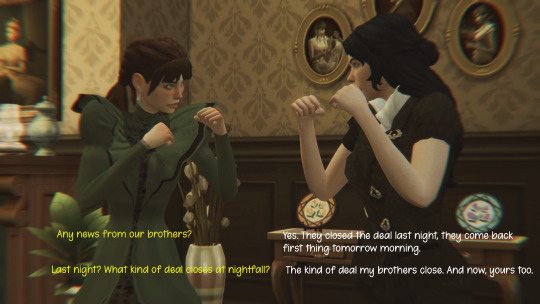
Helena suggested to Ann that they fight in her dress. If she was attacked, she would have to know how to defend herself with any kind of garment. Ann didn't understand why they would attack her though. they never had.
'Any news from our brothers?' asked Ann as they moved around the room without starting a fight.
'Yes. They closed the deal last night, they'll come back first thing tomorrow morning' replied Helena, tapping Ann lightly on the shoulder.
'Last night? What kind of deal closes at nightfall?' insisted Ann.
'The kind of deal my brothers close. And now yours too.' she replied, landing a second blow that Ann couldn't stop either.
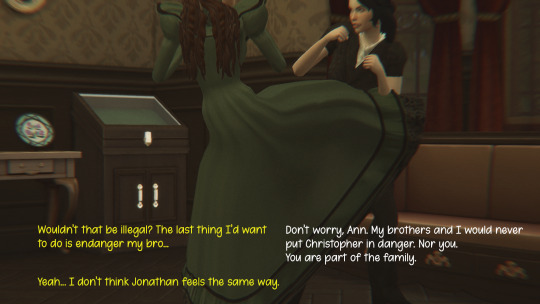
'Wouldn't that be illegal? The last thing i'd want to do is endanger my bro...' Ann began to say, before being interrupted by Helena so they could practice a specific move.
'Don't worry, Ann. My brothers and i would never put Christopher in danger. Nor you. You are part of the family' she replied at last.
'Yeah... I don't think Jonathan feels the same way' said Ann, just before she tried to kick Helena.

'Jonathan is somewhat withdrawn, he doesn't like meeting new people. But that doesn't mean he dislikes you' said Helena once she had pinned Ann to the ground.
'How long have you been training?' asked Ann, getting up from the floor.
'Since I was born. I knew how to fight before I could talk' replied Helena, laughing again.
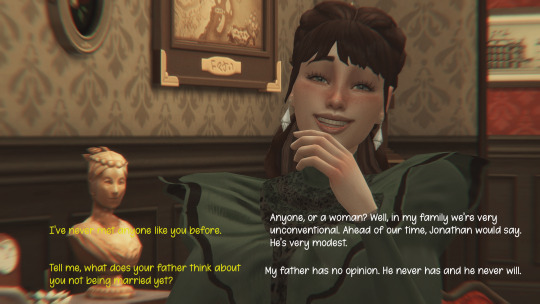
'I've never met anyone like you' said Ann with a chuckle.
'Anyone, or a woman?' asked Helena 'Well, in my family we're very unconventional. Ahead of our time, Jonathan would say. He's very modest'
'Tell me, what does your father thinks about you not being married yet?' asked Ann, still panting from the fight.
'My father has no opinion. He never has and he never will' replied Helena curtly.

'Jonathan!' shouted Helena after hearing the door bang.
'Jonathan? Wasn't he closing a...' Ann groaned. The last thing she wanted was to see Jonathan, for it was him she had been avoiding since the incident. Although the thought had only been in her head for a millisecond, Ann thought that maybe Jonathan had manipulated her mind to see a fire that never happened.
'No, he stayed in the manor' shouted Helena as she opened the door for her brother.
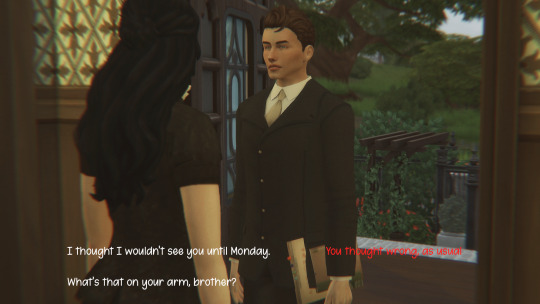
'I thought I wouldn't see you until Monday' said Helena.
'You thought wrong, as usual' replied Jonathan. He looked angry, as usual.
'What's that on your arm, brother?' asked Helena, raising her eyebrows.

As Ann walked through the door, Jonathan turned to her and held out the book without saying anything.
‘For me?' asked Ann, realising instantly that the question was unnecessary 'Thank you very much! Is it a book you have read' she asked.
'Helena told me you liked romance books' he said, and was silent for a few seconds. 'I don't.'

Helena persuaded Ann to accompany them to a bookshop that had opened a few days ago.
'The library is Jonathan's gift to the city' said Helena, smiling.
'Not exactly. The idea came from a friend who likes to read even more than i do' he replied almost in a whisper.
'How is it possible to surpass someone who has read more than 1,000 books at the age of 20?' asked Ann, who had to pick up the pace to catch up with the tall Cannadine brothers.
'Well... being 25′ replied Jonathan.
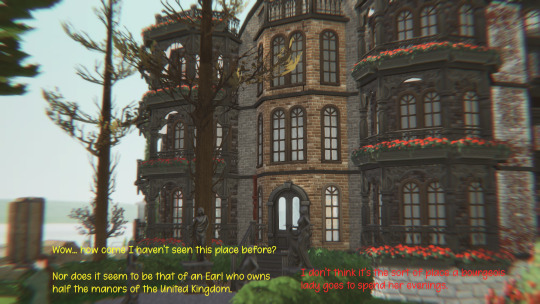
'Wow... how come i haven't seen this place before?' asked Ann in amazement at the sight of such a huge building.
'I don't think it's the sort of place a bourgeois lady goes to spend her evenings' said Jonathan, biting his lip to keep from laughing. The bookshop was in the poorest part of town, which made its size and beauty all the more strange to Ann.
‘Nor does it seem to be that of an Earl who owns half the manors of the United Kingdom' she replied, stepping forward in his footsteps.

‘Looks like we've lost my brother... tell me, which section do you want to snoop in?' asked Helena. Jonathan practically ran out as soon as they entered the bookshop, almost as if he had been waiting for that moment to run away from the situation.
‘Crimes. If Jonathan thinks I'm just into romance...' said Ann, laughing.
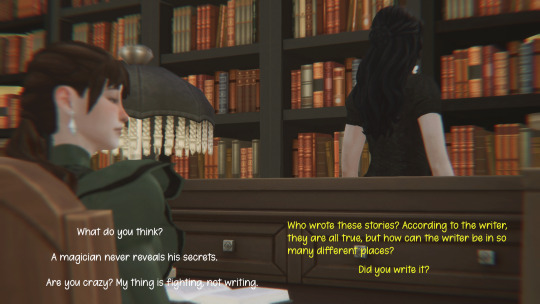
Helena held out a book to Ann with a black cover and a small signature on the bottom of it.
'What do you think?' asked Helena a few minutes later while still looking for a book for herself.
'Who wrote these stories?' asked Ann, confused. Helena approached her. 'According to the writer, they are all true. But how can the write be in so many different places?' insisted Ann. The stories told of brutal murders that would not have been punished but for the brave writer.
'A wizard never reveals his secrets' replied Helena, turning away again.
'Did you write it?' asked Ann.
'Are you mad? My thing is fighting, not writing.' replied Helena.
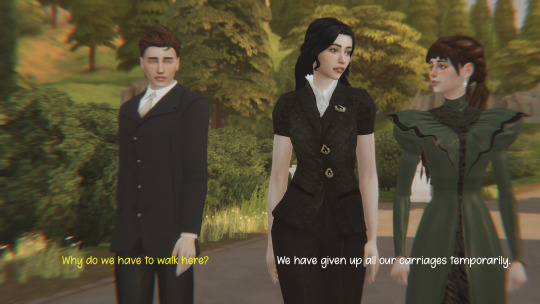
After a few hours of reading, Jonathan gave his sister a sidelong glance to start to leave and put the books away.
‘Why do we have to walk here?' asked Ann. It had only been a scant 15 minutes from her house to the bookshop, but the manor was on the outskirts, too far from everything to walk.
‘We have given up all our carriages temporarily,' Helena replied, biting her lower lip.

Once Ann began to glimpse the manor from afar, she noticed the many carriages lying parked at the entrance.
'What's going on?' she asked at the sight. But she got no answer. 'Helena?' she insisted.
'Don't worry, Annastasia. It's just a formality,' she replied, not looking her straight in the face.
'Believe me, Annastasia, no one dislikes this more than I do' said Jonathan, sighing.
At that moment, Ann had no idea what could be waiting for her in there.
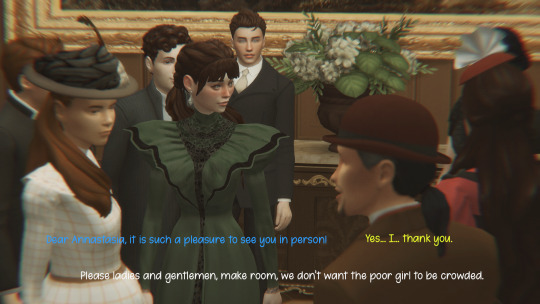
As soon as the front door of the manor opened, a bunch of faces unknown to Ann peered in with wide eyes and began to talk incessantly.
'Dear Annastasia, it's a pleasure to finally see you in person!' shouted one of them.
'Yes... I... 'Thank you' replied Ann, not quite sure who to turn to or where to look.
'Please ladies and gentlemen, make room, we don't want the poor girl to be crowded.' said Helena, taking Ann by the hand and leading her down the corridor.
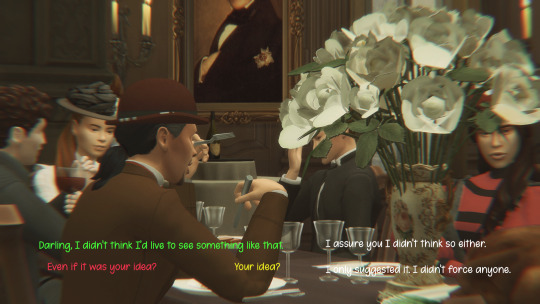
'Darling. I didn't think i'd live to see something like that' repeated one of the guests for the third time.
'I assure you i didn't think so either' replied Helena as she realised that she would not stop repeating that phrase if no one answered her.
'Even if it was your idea?' asked Jonathan, smiling half-heartedly.
'Your idea?' asked Ann, almost choking on her food.
'I only suggested it. I didn't force anyone' replied Helena, throwing up her hands.
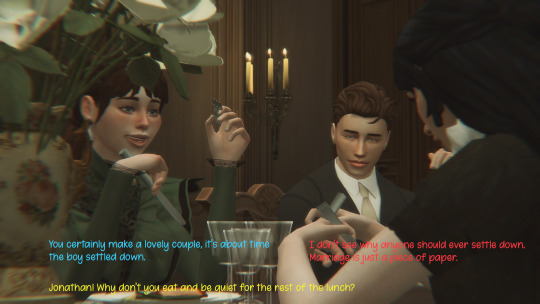
'You certainly make a lovely couple, it's about time the boy settled down.' said one of Helena and Jonathan's aunts. Ann couldn't help but wonder where their parents were and why they hadn't visited them since they moved to Southampton.
'I don't see why anyone should ever settle down. Marriage is just a piece of paper' said Jonathan, annoyed.
'Jonathan! Why don't you eat and be quiet for the rest of the lunch?' said Helena, giving a murderous look at her brother, who had begun to smile as he realised how much it annoyed his older sister. Ann couldn't help but smile too, it reminded her so much of the relationship she and her brother had, although Christopher was undoubtedly much more affectionate.
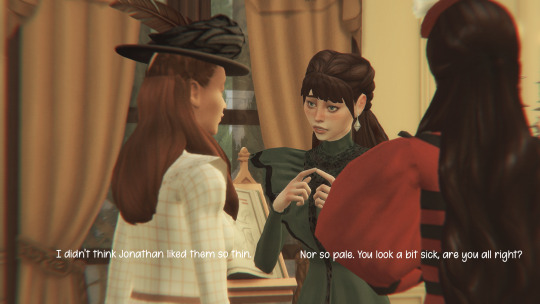
When dinner was over, Helena escorted the guests to another of the many rooms that were only on the first floor of the manor. As soon as Helena and Jonathan began chatting with distant relatives, two women approached Ann, looking down their noses at her with meanness. They just wanted to laugh at her, no one in that family understood why Jonathan would want to agree to such a wedding.
‘I didn't think Jonathan would like them so thin,' said one of them smiling.
'Nor so pale. You look a bit sick, are you all right?' asked the other, trying to feign distress as she put her hand to her heart.

'Excuse me, ladies' cried Helena, throat clearing as she saved Ann from the horrible situation. 'I need to speak to the future Countess Annastasia' said Helena, causing the two women to turn away without another word.
'You're my guardian angel, aren't you?' asked Ann, smiling again.
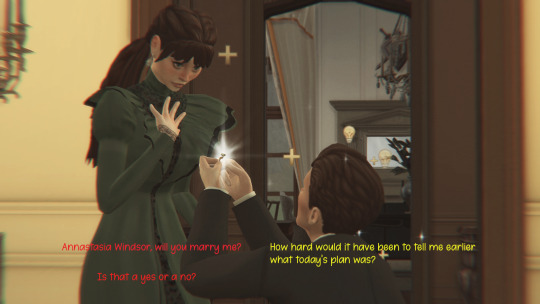
A few seconds later, Jonathan was crossing the wide room straight to Ann with a hint of amusement and annoyance in his eyes.
'Annastasia Winsdor, will you marry me?' he asked, getting down on one knee.
'How hard would it have been to tell me earlier about today's plan?' asked Ann. Cordelia had taught her to answer with questions when she got too nervous and didn't know how to make decisions. But this decision had already been made for weeks, she couldn't back out.
'Is that a yes, or a no?' insisted Jonathan, who had already stood up and was holding the ring almost as if he wanted to throw it away.

'A yes... I guess.' replied Ann at last.
23 notes
·
View notes
Photo




1620s dresses (from top to bottom) -
ca. 1620 Elizabeth Wriothesley, née Vernon, Countess of Southampton by Paulus van Somer (private collection), From tumblr.com/lenkaastrelenkaa 734X1000 @72 91kj.
ca. 1620 Lady called Margaret Stuart, Countess of Nottingham, by Paul van Somer (location ?). From tumblr.com/shewhoworshipscarlin; enlarged by half 900X1350 @72 410kj.
Young woman by Cornelis van der Voort (location ?). From tumblr.com/blog/view/froggi-mushroom/693248899675193344; fixed spots w Pshop & exp +25% & shadows 25% 1210X1651 @72 388kj.
Presumed portrait of Maria Caterina Farnese (1615-1646) by Nicolas Régnier (location ?). From tumblr.com/roehenstart 1159X1500 @72 967kj.
#1620s fashion#Louis XIII fashion#early Baroque fashion#Elizabeth Wriothesley#Paulus van Somer#curly hair#lace headdress#hair flower#high neckline#neckline ruff#paned sleeves#paned bodice#lace cuffs#Margaret Stuart#scoop décolletage#lace bertha#hanging sleeves#false sleeves#over-skirt#lining#Cornelis van der Voort#lace cap#stomacher#Basque neckline#Maria Caterina Farnese#Nicolas Régnier#floral headdress#bateau neckline#long paned virago sleeves
4 notes
·
View notes